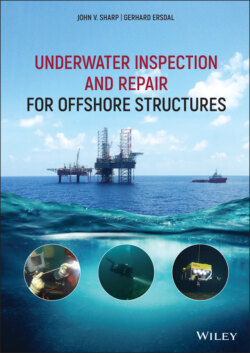Читать книгу Underwater Inspection and Repair for Offshore Structures - Gerhard Ersdal - Страница 16
1.3.1 Fixed Steel Structures
ОглавлениеFixed steel structures (jackets) consist of a steel spaceframe piled to the seabed (Figure 4 b), supporting a deck with space for drilling rigs, production facilities and crew quarters. Fixed steel structures are also used as a substructure for wind turbines. Steel jackets are usually made of tubular steel members. A typical six‐legged steel platform is shown in Figure 4 b. Historically, the piles were driven directly through the legs and into the seabed. In more recent platforms the piles are typically connected to the legs by pile sleeves where the annulus between the sleeve and the pile is grouted. In a few cases, a specialized suction pile (bucket foundation) has been used, for example the Norwegian platforms Draupner 16/11‐E and Sleipner T. In addition to the basic structure there are frames for the conductors, j‐tubes, risers and caissons needed for production and operation. J‐tubes are typically used to enable small diameter flowlines, electrical cables or pipeline bundles to be connected to the topside facilities. Steel structures are subject to ageing processes such as fatigue and corrosion and hence life extension is a key issue with regard to the structure itself.
Jack‐ups (Figure 4 a) are self‐elevating units with a buoyant hull and several legs which when on location can be lowered to the seabed and raise the deck above the level of the sea thus creating a more stable facility for drilling and/or production. During operation in an elevated situation, jack‐ups behave like a fixed platform. Jack‐up rigs have been primarily used for exploratory drilling, but there are a few instances where they have also been used for production.
Monopiles (Figure 5 c) support the deck on a single pile / tower. These types of structures are particularly used for offshore wind energy production.
